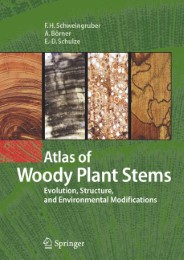Atlas of Woody Plant Stems (gebundenes Buch)
Atlas of Woody Plant Stems
Evolution, Structure, and Environmental Modifications
Erschienen am
25.07.2006
Bibliographische Informationen
ISBN/EAN: 9783540325239
Sprache: Englisch
Seiten: x, 229 S.
Fomat (h/b/t): 1.1 x 30.5 x 21.6 cm
Auflage: 1. Auflage 2008
Bindung: gebundenes Buch
Beschreibung
InhaltsangabeIntroduction1 1 The Evolution of Plant Stems in the Earth's History The Landscape in the Paleozoic Plant Body of Vascular Plants The Evolution of a Stabilizaton System The Contemporary Fossil Psilotum Nudum? Diversification of Plants Containing Tracheids The Lycopods The Horsetails The Fossil and Living Ferns Contemporary Ferns Trees Grow Taller and Bigger Successful Seed Plants with Naked Seeds Ginkgos and Cycads Gnetophytes (Ephedra, Gnetum and Welwitschia) The Most Successful Seed Plants with Naked Seeds: Conifers Successful Plants with Seeds Enclosed in a Carpel: Angiospermae 2 The Structure of the Plant Body Life Forms in Different Vegetation Zones Principal Growth Forms Principal Construction of Roots and Shoots Principal Construction of the Xylem and Phloem Cell Types, Cell Walls and Cell Contents 3 Secondary Growth: Advantages and Risks Primary and Secondary Growth Principle Structure of Plants with Secondary Growth Physiological and Ontogenetic Ageing The Risks of Water Transport: Stabilized and Permeable Cell Walls The Risks of Stem Thickening: Dilatation and Phellem Formation The Risks of Over-Production: Programmed Cell Death The Risks of Instability: Eccentricity Reaction Wood Formation of Lignin and Thick Cell Walls Internal Optimization The Risk of Decomposition: Natural Boundaries and Protection Systems Defence Barriers around Wounds The Risk of Shedding Plant Parts: Abscission 4 Modification of the Stem Structure The Primary Stage of Growth: The Construction of Vascular Bundles TheArrangement of Vascular Bundles in Mosses, Lycopods and Ferns The Arrangement of Vascular Bundles in Conifer and Dicotyledonous Plant Shoots The Secondary Stage of Growth: Conifer Xylem The Xylem of Dicotyledonous Angiosperms The Primary and Secondary Stages of Growth of Monocotyledons: Macroscopic View Microscopic View The Secondary Stage of Growth: Conifer Phloem The Phloem of Dicotyledonous Angiosperms Cambial Growth Variants and Successive Cambia The Third Stage of Growth: The Periderm 5 Modification of the Xylem within a Plant Modification of the Xylem within a Plant Conifer: Root, Twig and Stem Deciduous Tree: Root, Twig and Stem From Root to Stem Structure Modification by Aging: Changing Growth Forms Changing Growth and Leaf Forms Changing Wood Anatomical Structures Change of Phloem and Periderm Structures 6 Modification of the Xylem and Phloem by Ecological Factors Intra-Annual Density Fluctuations, Phenolic and Crystal Deposits Intra-Annual Cell Collapse, Callous Tissue and Ducts Interannual Variation of Latewood Zones Long Term Variations: Sudden Growth Changes Inter- and Intra-Annual Variations of the Phloem 7 Modification of Organs Modification of Shoots: Long and Short Shoots Shedding Needles, Male and Female Flowers Thorns and Spines Vertical, Horizontal and Drooping Twigs Latent and Adventitious Shoots The Lateral Modification of Stems 8 Anatomical Plasticity Wood Structural Variability In Different Families In Different Growth Forms Under Different Site Conditions Modification Caused by Different Shoot and Root Function
Inhalt
Introduction1 1 The Evolution of Plant Stems in the Earth¿s History The Landscape in the Paleozoic Plant Body of Vascular Plants The Evolution of a Stabilizaton System The Contemporary Fossil Psilotum Nudum? Diversification of Plants Containing Tracheids The Lycopods The Horsetails The Fossil and Living Ferns Contemporary Ferns Trees Grow Taller and Bigger Successful Seed Plants with Naked Seeds Ginkgos and Cycads Gnetophytes (Ephedra, Gnetum and Welwitschia) The Most Successful Seed Plants with Naked Seeds: Conifers Successful Plants with Seeds Enclosed in a Carpel: Angiospermae 2 The Structure of the Plant Body Life Forms in Different Vegetation Zones Principal Growth Forms Principal Construction of Roots and Shoots Principal Construction of the Xylem and Phloem Cell Types, Cell Walls and Cell Contents 3 Secondary Growth: Advantages and Risks Primary and Secondary Growth Principle Structure of Plants with Secondary Growth Physiological and Ontogenetic Ageing The Risks of Water Transport: Stabilized and Permeable Cell Walls The Risks of Stem Thickening: Dilatation and Phellem Formation The Risks of Over-Production: Programmed Cell Death The Risks of Instability: Eccentricity Reaction Wood Formation of Lignin and Thick Cell Walls Internal Optimization The Risk of Decomposition: Natural Boundaries and Protection Systems Defence Barriers around Wounds The Risk of Shedding Plant Parts: Abscission 4 Modification of the Stem Structure The Primary Stage of Growth: The Construction of Vascular Bundles The Arrangement of Vascular Bundles in Mosses, Lycopods and Ferns The Arrangement of Vascular Bundles in Conifer and Dicotyledonous Plant Shoots The Secondary Stage of Growth: Conifer Xylem The Xylem of Dicotyledonous Angiosperms The Primary and Secondary Stages of Growth of Monocotyledons: Macroscopic View Microscopic View The Secondary Stage of Growth: Conifer Phloem The Phloem of Dicotyledonous Angiosperms Cambial Growth Variants and Successive Cambia The Third Stage of Growth: The Periderm 5 Modification of the Xylem within a Plant Modification of the Xylem within a Plant Conifer: Root, Twig and Stem Deciduous Tree: Root, Twig and Stem From Root to Stem Structure Modification by Aging: Changing Growth Forms Changing Growth and Leaf Forms Changing Wood Anatomical Structures Change of Phloem and Periderm Structures 6 Modification of the Xylem and Phloem by Ecological Factors Intra-Annual Density Fluctuations, Phenolic and Crystal Deposits Intra-Annual Cell Collapse, Callous Tissue and Ducts Interannual Variation of Latewood Zones Long Term Variations: Sudden Growth Changes Inter- and Intra-Annual Variations of the Phloem 7 Modification of Organs Modification of Shoots: Long and Short Shoots Shedding Needles, Male and Female Flowers Thorns and Spines Vertical, Horizontal and Drooping Twigs Latent and Adventitious Shoots The Lateral Modification of Stems 8 Anatomical Plasticity Wood Structural Variability In Different Families In Different Growth Forms Under Different Site Conditions Modification Caused by Different Shoot and Root Functions 9 Modifications Caused by Weather and Climate Major Wood Anatomical Types in Different Climatic Regions Modification o ...
Andere Artikel von "Schweingruber, Fritz Hans/Börner, Annett/Schulze, Ernst-Detlef"
Vergriffen

Lieferbar innerhalb 14 Tagen

Lieferbar innerhalb 14 Tagen

Weitere Artikel aus der Kategorie "Biologie/Botanik"
Vergriffen

Lieferbar innerhalb 24 Stunden

Lieferbar innerhalb 24 Stunden

Lieferbar innerhalb ca. einer Woche










